Artisan Vu Van Gioi is introducing two imperial robes which he successfully restored recently at one of his workshops. One of them is a prototype of the robe worn by Queen Tu Cung, mother of Bao Dai, Vietnam’s last emperor, whose reign ended in 1945. Mr. Gioi, who was born in a traditional family in Dong Cuu, a village which specialized in embroidery in Thuong Tin, Hanoi, has been recognized as the one and only master artisan who can properly reproduce the precious royal robes. Gioi has devoted more than 20 years to restoring old embroidery designs, including traditional festive decorations and royal costumes. Each costume has strict designs and complex color combinations, which may take several years to finish. Gioi spoke more about this traditional art form.“As in the legend, the saint of the embroidery craft in Vietnam was Doctor Le Cong Hanh, who lived at the end of the Tran Dynasty. In the past, only skilled artisans from all embroidery villages nationwide were invited to make sophisticated costumes for the King, the mandarins and all the nobles. The king’s robes were made using 24K gold threads while the queen, princes and princesses’ robes were made of 22K and 18K gold threads. Even the smallest decorative items were gold -plated and carefully sewn to the costumes. Thus, to create beautiful items, an artisan should not only be patient, meticulous, but also needed to have an artistic sense for design and combining colors.”
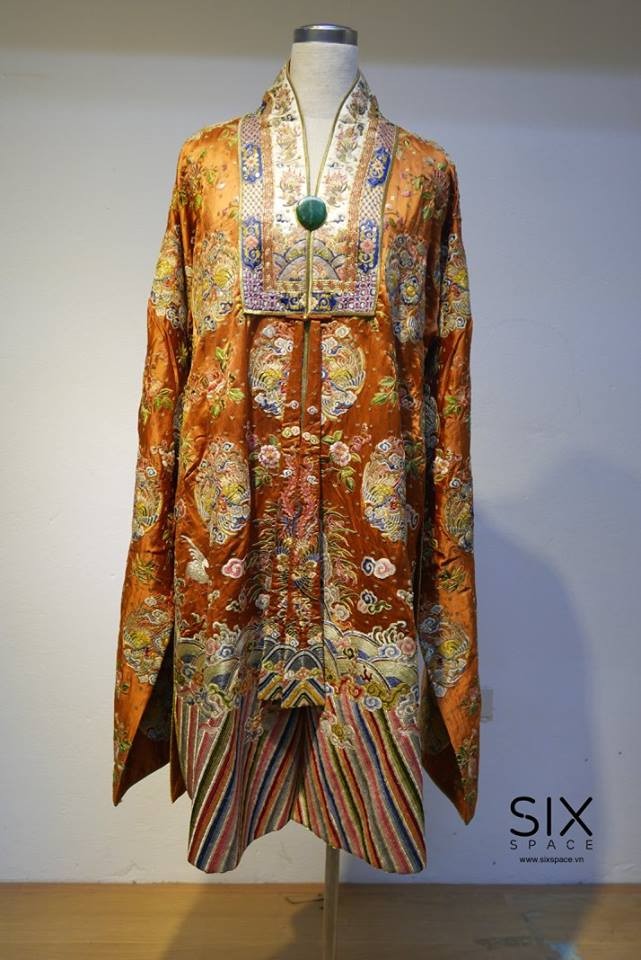 |
| A prototype of the robe worn by Queen Tu Cung, mother of Bao Dai, Vietnam’s last emperor, whose reign ended in 1945 (Source: Sixspace's official FB) |
Clothes for royalty were always made of the highest-quality silk and every pattern or symbol embroided on it has meaning. An emperor's robe had nine dragons, in which the biggest one, on the chest, represented power and strength. Whereas, lady's robes are decorated with phoenixes, flowers, and butterflies to represent their smoothness and beauty. For Gioi, the longer he has been at the work, the more he realizes how beautiful and sophisticated traditional patterns are. He said. “To me, every traditional design and pattern has its own value and hidden meaningful stories. Only when you touch the threads and draw the patterns onto the fabric yourself, will you feel how beautiful and smooth, and natural these traditional patterns are. Royal embroidery not only requires highly professional skill and strict accuracy; it’s created by the blend of artists’ souls.”
.jpg) |
| Each costume has strict designs and complex color combinations, which may take several years to finish (Source: Sixspace's official FB) |
When doing embroidery, it is not only about stitching but about bringing the beauty of life to the art work. Embroidery artist Pham Ngoc Tram, who has been using embroidery as a material for modern art creation, shared: “I can learn and understand more about our ancestor’s thoughts and life perceptions through every detail embroided on their costumes. If you pay attention, you will easily recognize that the flowers embroided by artisans are far more beautiful and realistic than the mass productions that are available out there. When looking at the traditional works, I feel like even the smallest detail could tell the story of a philosophy of life.”
Although the royal embroideries of some Asian countries like Vietnam, Japan, China, and Korea have similarities and differences, Vietnamese royal embroidery still has its own characteristics, which can easily be distinguished from the art of other countries. Lee Jung Hee, an artist from the Republic of Korea, who is famous for her sophisticated embroidered pieces, said: “There is a big difference between Vietnamese and Korean embroidery art. When looking at Vietnamese traditional patterns, it seems like all the objects, animals, and plants are real, whereas the Korean royal embroidery art symbolizes these motifs that wish longevity, luck, and wealth. However, in Korea, there are some special colors that were used only for members of the royal family, such as red and yellow.”
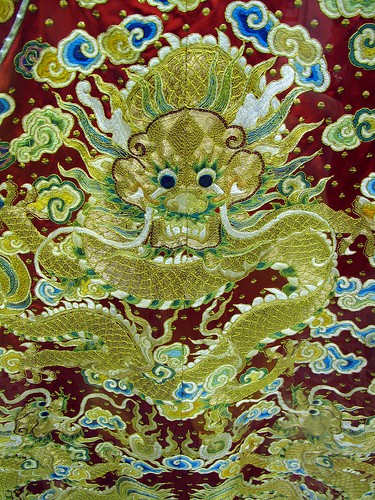 |
An emperor's robe had nine dragons, in which the biggest one, on the chest, represented power and strength (Source: Sixspace's official FB)
|
By combining traditional embroidery techniques with creativity and the aesthetic eye of the embroiderers, the works include exquisitely harmonious colors and subtle textures to each line. However, the road to mastering the craft of royal embroidery wasn’t as smooth as silk. To be able to embroider such meticulous and soulful patterns, the artisan has had to practice for years. Gioi again: “Embroidery artisans should practice for years to understand the finger sensation with the needles and threads. When embroidering, fingernails should be cut carefully as we only use the finger tips to control the needles and threads. The embroiders’ hands are different from others, normally, their little fingers stretch and the finger number 1,2,3 often worn out after years of working.”
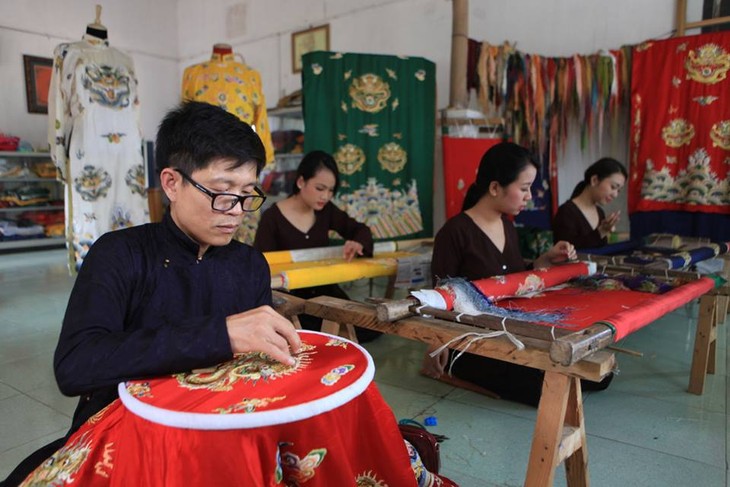 |
By combining traditional embroidery techniques with creativity and the aesthetic eye of the embroiderers, the works include exquisitely harmonious colors and subtle textures to each line
(Source: Sixspace's official FB) |
Learning from Gioi the way to hold the needles and combine colors through the work that Vu Gioi has restored, Pham Ngoc Tram has harmonized and created a new style. She said: “When I learn and practice this art form, I feel free to tell my own stories through the traditional language of needles and threads from the perspective of a young person who deeply loves and treasures those traditional values.”
After eye-witnessing Gioi’s intricate patterns and Tram’s contemporary work arts, Mignon from South Africa can’t hide her emotions. She said: “I think it’s beautiful and I think it’s really great that he’s trying to restore the art form. You know it’s mass produced. There’re so much more emphasis on quantity rather than quality. So that’s why I find it’s really interesting. Looking at how imperial royal embroidery is surviving today, but also looking at how all this art form has been portrayed in contemporary life. So it’s really interesting.”
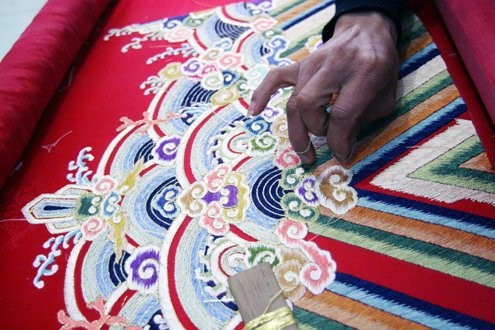 |
The embroiders’ hands are different from others, their little fingers stretch after years of working
(Source: Sixspace's official FB) |
It’s clear that more effort is needed to preserve and promote Vietnamese royal embroidery. Tram shares her recommendations: “The more I research in this field, the more I realize that Vietnamese traditional embroidery, especial royal embroidery, has many prominent characteristics that need to be introduced to the public. I suggest that we could publish a book about this art form, or even make a series of videos teaching traditional and royal embroidery.”
Talking about the ways to bring royal embroidery closer to life, Gioi said: “Royal embroidery requires passion and patience alike, thus, I’m now still finding susscessors to take over my work. I’m thinking about working with some young people who love this art form, to pass some of my experiences and knowledge on, in the hope that the royal embroidery will be known about and loved by more people.”
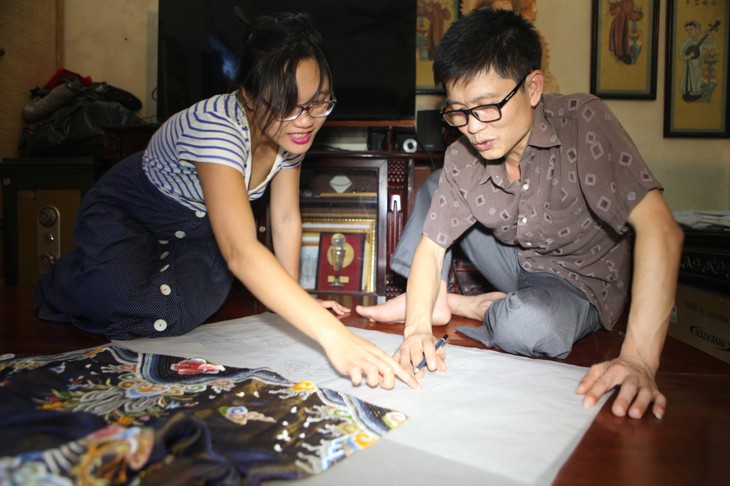 |
| Gioi is thinking about working with some young people who love this art form, to pass some of his experiences and knowledge on, in the hope that the royal embroidery will be known about and loved by more people (Source: meomeoembroidery.com) |
Nowadays, embroidery has developed to become part of contemporary textile art and provided a great source of inspiration for Vietnam’s young designers and artists.
- “I’m a designer, so I want to apply royal embroidery patterns to my designs to bring it closer to the markets and my customers.”
- “When watching other Asian countries’ films, I was really impressed by their traditional costumes. And then suddenly I asked myself that “why Vietnamese traditional costumes, which are so beautiful, with their meticulous and elegant embroided decorations, are not more widely known, both inside and outside Vietnam?” I myself think that we need more effort in publicizing the images of embroided costumes to display the beauty of Vietnamese traditional culture to the world.”
This week, we’ve been talking about Vietnamese traditional embroidery. We welcome your feedback at: English section, VOVworld, Radio Voice of Vietnam, 45 Ba Trieu Street, Hanoi, Vietnam. Or you can email us at: englishsection@vov.org.vn. Tune in to our English program on the Internet at vovworld.vn. Good bye. See you next time.